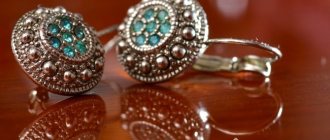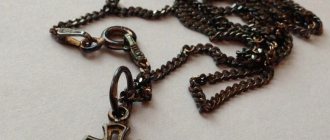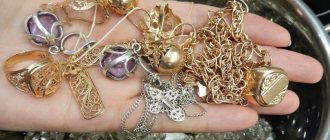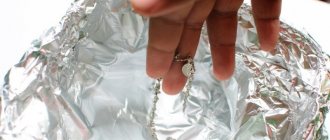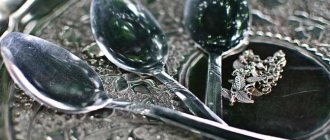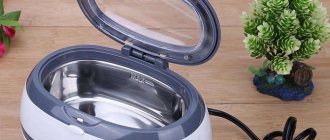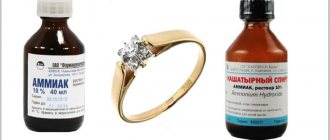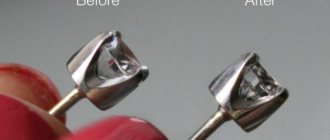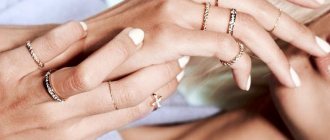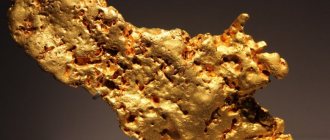Before you start cleaning inlaid jewelry yourself, you should take into account the fact that complex jewelry does not tolerate contact with a humid environment and aggressive chemicals. The shine of precious stones, as well as gold and silver, is achieved through polishing. The only difference is that polishing stones is a more complex and responsible procedure. If cleaning is done incorrectly, any abrasive leaves micro-scratches, which are extremely difficult to get rid of on your own. As a result, the stone almost ceases to shine.
Cleaning silver with improvised means at home
To clean silver at home, three products that are found in every home are most often used: baking soda, ammonia and hydrogen peroxide.
You can clean silver in the following ways:
- Cleaning with baking soda. In order to clean products with soda, you need to dilute it with water to a paste. Next, you need to thoroughly rub the product with this paste until it shines and wash it in clean water. However, you should be careful, as grains of soda can cause small scratches on the product.
- Cleaning with ammonia. There are two ways here. First: you need to dilute the chalk with ammonia to a paste and rub the product with this substance until it shines, and then wash it. Second: immerse the product in a 10% solution of ammonia for 15-25 minutes (depending on the degree of contamination of the silver).
- Cleaning with hydrogen peroxide. You need to thoroughly wipe the product with peroxide until it is completely clean. It is important to know that peroxide does not react with either gold or silver, however, it does react with many other metals. Therefore, you should not use this method without knowing which metals are in the silver alloy (if the product is made of an alloy).
It is important to remember one more point: before any cleaning, the silver needs to be kept for some time in a concentrated solution of soap or other soapy detergent, and only then proceed directly to the procedure itself.
Washing jewelry
It was previously believed that when the largest gemstones faded, the stones also lost their mystical and magical properties. This especially applied to healers, kings and those close to them. There were even specially trained people whose main task was to clean precious stones until they shine and at the same time so that they do not lose their color and mystical properties. Particular attention was paid to such jewelry as signets and crowns, but it was the largest men's signets in the world with large stones that were the most difficult to clean.
And today, in order to clean various and even the most expensive men's mystical signets in the world and other most precious jewelry, it is enough to simply obtain qualifications from an experienced jeweler and have the necessary tools, things and substances with you. And at the same time, you must also comply with the conditions for cleaning precious items, their proper storage, and then your precious stones, like precious jewelry, will always look like new. You will be able to enjoy their beauty for a long time.
And finally, a piece of advice: if you do not have such knowledge and skills and are worried that you might damage your product or jewelry, it is better to entrust the work to a professional jeweler. Not only will he do this job efficiently and effectively, but he will also save your time.
Cleaning gold with improvised means at home
Here's how you can clean gold:
- Clean with soap or detergent solution. In a small saucepan, prepare a concentrated solution of liquid soap or detergent. At the bottom, placing a piece of soft cloth underneath, place the gold item. Boil it for a few minutes and wipe thoroughly.
- Cleaning with powder and ammonia. In a glass of hot water, dilute a tablespoon of washing powder and ammonia. Leave the product in this solution for 1-2 hours.
- Cleaning with saline solution. You need to prepare a concentrated saline solution (about 2-3 tablespoons of salt in half a glass of water) and leave the product in it overnight, and rinse thoroughly in the morning.
- Cleaning with a sugar solution. This recipe differs from the previous recipe only in one component - instead of salt you need to use sugar.
Unusual cleaning methods
There are other options for using improvised means to clean gold accessories:
- Before polishing, the gold is rubbed with lipstick.
- Gold jewelry can be soaked in Coca-Cola for 0.5 hours.
- A solution is poured into a bowl, wrapped inside with foil, in the proportion: 20 g of soda per 200 g of water. Products are soaked for 24 hours.
- Moisten cotton swabs or disks with table vinegar and wipe accessories with them.
- Toothpaste is a common way to clean gold with stones. This method does not require immersing accessories in water.
- A composition of chalk (3 pieces) and ammonia (5 tablespoons) is applied to gold jewelry with stones for a few minutes.
- Products are soaked in contact lens liquid in the evening and left until morning.
- Gold is rubbed with a fresh cut of half an onion.
In specialized stores, along with instructions for use, they sell products for cleaning gold with stones.
In liquid media, the products are kept for the specified time. Accessories are moistened with sprays before polishing. The paste is applied to the surface, the most contaminated areas are rubbed.
Cleaning items with stones
However, cleaning simple metal products is not difficult at all. Difficulties arise when the product is inlaid with some kind of stone.
Depending on the hardness level of the stone, there are three types:
- Precious stones (those with a hardness rating greater than 5). These include diamonds, emeralds, rubies, sapphires and others. Such stones are quite resistant to scratches.
- Semi-precious stones (having a hardness coefficient below five). These include turquoise, malachite, moonstone, opal and other minerals. They are quite sensitive and can be damaged after prolonged contact with water and other liquids.
- Organic stones. These include corals, amber, and natural pearls. They do not tolerate alkaline and acidic environments, as well as contact with ammonia.
Each of these types of stones requires special care. And, accordingly, the jewelry in which they are contained, too. Let's look at it in more detail.
Cleaning items with precious stones
Methods for cleaning items with precious stones:
- Such products can be thoroughly cleaned with alcohol. Soak a cotton swab in alcohol and gently wipe the product, including all hard-to-reach places. Then rinse off the alcohol by dipping the item in a water solution and dry the item with a dry cloth.
- You can wash the product using a soft cloth soaked in a concentrated soap solution or a solution of washing powder.
- Diamond-encrusted jewelry can be easily cleaned with a soft toothbrush dipped in soapy water.
- Also, jewelry with diamonds can be cleaned in a weak solution of ammonia (six drops per glass of water), immersing the product there for half an hour.
- If a grease deposit has formed on the product, you can get rid of it using the same toothbrush dipped in gasoline.
Cleaning items with semi-precious stones
Such stones do not tolerate prolonged contact with water, acids and alkalis. Therefore, the most effective and at the same time gentle way to clean such stones is a soap solution. You need to thoroughly rinse the product in it, and then wipe it with a soft cloth.
Cleaning products with organic stones
For organic stones, you can use the following cleaning products and methods:
- Rinse the product in an alcohol solution (50% solution).
- Pearls require especially careful care. It should be cleaned with a soft brush dipped in soapy water. Then the decoration should be rinsed with water. You can learn more about one type of pearl - baroque pearls - here.
- Amber and coral are cleaned dry, by rubbing with a suede or flannel cloth.
Accumulation of energy by stones
It is worth keeping in mind that you will never be able to experience the pristine purity of the stone you have become the owner of. If it was inherited, it passed through the hands of many generations. If you independently purchased jewelry in a store, then strangers took part in its creation, and the mineral became the owner of someone else’s information, and not always positive. Only a found gem can boast of natural purity. But such cases are isolated.
Most often, noble stones are objects of energy accumulation. Those minerals that are intended to be used for medicinal purposes must undergo complete purification. This is especially true for crystals that came to a new owner from deceased relatives or friends. Onyx is considered to be the most dangerous unrefined stone. As for citrine, it is enough for it to have proper and constant care or simply undergo regular cleaning with regularity.
Stones can be treated differently. You can love them and hate them, sometimes there is a cold attitude. But you need to remember one simple truth. If you want to have constant protection, an assistant, an adviser, then you need to find not only a common language with the stone, but also find inner harmony. There are several rules to follow:
- Don’t think that the mineral will begin to work wonders the next day after it appears. In order for you to perceive his help, you need to get used to each other, complete mutual understanding. This is achieved after a certain period of time.
- To obtain a positive effect in the future, it is necessary to clean the newly acquired stone. Why cleanse? Because during their existence on Earth, minerals absorb all the energy that is in close proximity to them. This could be the energy of the Sun, Moon, the planet itself, people who have been in contact with gems, and so on. To get rid of energy and information traces, it is necessary to clean them.
- Once the cleaning is completed, the stone should be left to rest for a couple of weeks. During this time he rests and gains strength. The next step is charging it. The methods can be different: the light of the Moon or the Sun, herbs, salt, and so on.
- You need to respect and love your talisman. This has a positive effect on his qualities. All gems need to be monitored, cared for, and regularly cleaned, the regularity of which depends on how you use your amulet. This could be simply wearing jewelry, performing medical procedures or magical rituals with his participation.
- In situations where the stone turns pale, becomes heavier, or loses its shine and beauty, jewelry with it must be removed and left for a couple of days in a separate case, away from prying eyes.
- If you do not want to lose the respect of your amulet, then try never to give it to anyone, even for a while. This is fraught with negative consequences after returning. The most harmless thing is that the stone will stop helping you in life. But there are times when a stone is “offended” and begins to take revenge on its owner. This can lead to the development of chronic diseases in a person, fatigue, constant bad mood, and apathy. Luck turns away from him, and problems begin at work.
- Cleaning and charging the mineral must be done independently, in a good mood and with bright thoughts.
What you should pay attention to? For possible changes in the stone. It can change shade, become dull, “lifeless,” heavy, and being near it leads to irritability, nervousness, hot temper, and recklessness. This suggests that your talisman is very tired and simply needs to be cleansed of accumulated negativity. Give him the opportunity to rest and regain lost strength in order to support you in the future and lead you out of dead-end situations.
Caring for Individual Stones
Rules for caring for some stones:
- Diamond and sapphire. These stones should be cleaned with ammonia or soap solution, wiping with a soft cloth intended for optical glasses. It is worth protecting stones from sudden impacts or exposure to high temperatures.
- Emerald, topaz, ruby. Only professional cleaning products are used for these stones. Cleaning at home can damage the stone.
- Amethyst, garnet. These stones can also be cleaned in soapy water using a soft cloth or brush. Ultrasonic cleaning is also used. These stones don't like harsh ones. temperature changes.
- Aquamarine, chrysolite. These stones are cleaned by washing them in a solution of ammonia or washing powder. However, the solution should be slightly warmed up, but in no case hot. Avoid contact with acids on stones.
- Opal, turquoise. These stones can be cleaned at home only with a dry suede cloth. Under no circumstances should these stones be washed or ultrasonic cleaned.
Prepare jewelry for cleaning
Jewelry with stones is more difficult to care for. When using any method, you need to prepare for the event and act correctly.
Many materials cannot withstand aggressive environments and require delicate handling. To avoid damaging the product, you need to know:
- type of stone;
- method of fastening (glue, clamp);
- the presence of additional inlay inserts.
The sophistication of the jewelry is given by the framing of diamond, ruby, and sapphire chips, which are attached with glue. Soft stone is also fixed with adhesive. Our task is to maintain the integrity of the product, so be sure to consider the type of fastener.
Mechanical actions may cause the stone to fall out. Photo: stozabot.com
Many materials cannot tolerate chemical solutions or contrasting temperatures. If there are gemstones, standard gold methods cannot be used.
Jewelry recommends how to care for gold:
Jewelry advises on its website how to care for gold items
Rules for the care and storage of jewelry
Jewelry storage:
- The jewelry should be stored in a box lined with soft fabric inside.
- Products should not be in constant contact with each other while in the box. Therefore, it is worth choosing a box with multiple compartments or placing jewelry in soft fabric bags before putting it in the box.
- Semi-precious stones can deteriorate from constant contact with direct sunlight. Therefore, for them, the presence of a box is a prerequisite.
- Also, some stones can deteriorate from heat or strong temperature changes. Therefore, the box should be placed away from heat sources.
Professional care:
- About once a year, your jewelry should be professionally cleaned by a jeweler.
- The cleaning process involves polishing with a special cleaner and placing the jewelry in an ultrasonic bath (only for those types of stones that are suitable for this).
- The jeweler will also be able to prevent stones from falling out of the jewelry and secure the clasps.
- You can consult with him about cleaning and caring for your jewelry and purchase stone cleaning products that he recommends.
What jewelry is afraid of:
- Temperatures. When heated, the stones attract dust and grease, so after this they will not be able to shine as brightly in the sun as before.
- Mechanical impact. Microcracks appear on stones and metal due to mechanical stress. They may be invisible to the naked eye, however, this causes the products to lose their original shine and become dull.
- Cosmetics. Components that make up cosmetics can react with metals and have a detrimental effect on them. This may cause stains on the decoration. Apply various creams and lotions only after removing jewelry.
Other general care rules:
- You should always remove jewelry at night and when doing housework. Playing sports, taking a shower.
- It is also worth protecting products from getting perfume on them, as this can lead to stains on the metal.
- Get a special cloth made of soft material (for example, microfiber) for your jewelry and wipe the jewelry with it daily after removal.
- Pearls, as a very vulnerable organic stone, should be kept away from all other jewelry, wrapped in soft cloth. Also, if pearls are not worn for a long time, they may become tarnished. Therefore, it is recommended to wear it periodically.
Types and causes of pollution
Before you clean the stone on your ring, you need to determine the type of contamination. Most often, the jewelry gets dirty in the places where the stone is attached and the sample is printed.
Due to the fact that gold is a very soft and malleable metal, it is easily subject to deformation. To increase the strength of products, jewelers often use alloys of gold with silver or copper. In addition to increasing durability, foreign metals pose the risk of oxidation upon contact with another environment or skin.
The unattractive condition of gold jewelry also contributes to:
- sweat and fat discharge;
- cosmetics for face and hands;
- contact with household chemicals;
- environment.
Important! The sweat and fat secretions transfer to the stone, which significantly reduces the shine. When removing them, it is strictly forbidden to use abrasive liquids to clean silver.
Bottom line
Let's summarize:
- To ensure that gold and silver jewelry with stones do not lose their appearance and delight the eyes of their owners for a long time, they need special care and periodic cleaning.
- To clean gold and silver items, improvised means such as baking soda, ammonia, soap and other detergents, and hydrogen peroxide are most often used. Solutions and mixtures of these substances are used in different proportions and concentrations, depending on the material and complexity of the contamination. This cleaning is also suitable for marcasite jewelry in silver.
- Products with stones require more careful care.
- All stones are divided into three types: hard precious stones, more fragile semi-precious stones and organic stones. Each type of stone requires special care.
- For each stone, there are recommended cleaning methods and rules for handling it. They also need to be taken into account.
- Jewelry should also be protected from exposure to chemicals, prolonged exposure to water, technical damage, heat and sudden temperature changes, and cosmetics.
- Jewelry should be stored in a special box with a soft covering.
- At night, jewelry should be removed and wiped with a soft cloth.
- Approximately once a year, jewelry should be taken to a jewelry workshop for professional cleaning. You can also buy special cleaning products for jewelry there.
How to save your cleaning results
No matter what jewelry is made from, they all require maintenance sooner or later. However, you can increase the period without cleaning, you just need to use and store your jewelry correctly. To do this, you need to know why silver darkens and how to neutralize this process.
Causes of silver contamination:
- presence of metal in rooms with high humidity;
- contact with saline solutions, cosmetics, household gas, etc.
If you eliminate these reasons, you won’t have to clean your jewelry often. To do this, you need to follow the recommendations:
- store silver jewelry separately from gold and other jewelry;
- taking a shower, visiting a swimming pool, sauna, bathhouse, etc. remove jewelry;
- prevent the ingress of household chemicals, including their evaporation - when cleaning, remove precious items;
- do the same when playing sports.
If you follow these simple recommendations, your jewelry will always look great and delight you with its aesthetic appearance.
Follow the rules
Stones in gold jewelry quickly become dirty. If you decide to do the cleaning yourself, follow the basic rules:
- An aqueous solution of ammonia 1:6 will help remove dirty deposits The method is suitable for cubic zirconia, citrine, zircon, ruby.
- Do not soak in aggressive solutions - if the stones are glued, they will fall off.
- Do not use ammonia or abrasive substances when cleaning soft stones: coral, pearls, turquoise, amber, hematite, etc.
- Do not clean gold with stones with sharp objects : a needle, a toothpick.
- Do not wash transparent stones (aquamarine, alexandrite, etc.) with soapy solutions - the shine and play of light disappear. They are cleaned with starch, microfiber, flannel.
- Maintain regular care - jewelry that is worn every day should be cleaned monthly.
Jewelry will become dirty less often if you follow the recommendations:
- Remove jewelry when coming home, taking a bath/shower, going to the beach, solarium, or any place exposed to sea water, UV and sweat.
- Protect from contact with perfumes and creams.
- Store away from ultraviolet radiation, moisture, on soft pads/velvet.
Types of precious stones
Expensive gold items with half-hidden stones, including diamonds, are best left to a specialist. The cleaning service is inexpensive and guarantees safety.
Polishing pastes and powders
Protective polishing pastes produced at home, in addition to the above-mentioned components, additionally include mineral powdered fillers (volcanic glass, finely ground quartz, pumice, etc.), the purpose of which is a grinding and polishing effect. However, as practice has shown, the use of such pastes has no advantages over soap compositions; If the mineral powder is not fine enough (if there is a residue on sieve No. 280), they cause a rapid loss of gloss.
The best means to restore the mirror shine are tin powder (for white marbles), chromium oxide and aluminum oxide, applied in the usual way. GOI pastes intended for glass are not suitable.
How to wash the facade of buildings and structures
This method includes: washing with water, cleaning with steam and sand, as well as restoring the original texture using secondary reforging of the surface or grinding.
Washing with water (with a hose under high pressure) is used when the external cladding is completely intact and only slightly dirty; it is most effective on mirror textures.
To wash the interior lining, use rubber sponges or clean linen (canvas) rags; washing is carried out from top to bottom, in horizontal stripes, with excess water. It is recommended to use water infused with marble dust; Distilled water is not suitable for washing, as it actively dissolves the surface of the marble, causing a rapid loss of polish.
Non-carbonate rocks (granite, labradorite, etc.) can be washed with water without pre-treatment.
Washing with water using brushes is carried out to clean external and internal cladding with mirror-like polished and finely ground textures, as well as sculptural reliefs and cuts, when the surface of the cladding does not show signs of destruction, but is heavily soiled.
With rough textures and porous stones, contamination spreads to a considerable depth and significant mechanical force is required to remove it. Brushes can be hair (artificial wool) or herbal. The use of steel brushes is not permitted.
Chemical additives, such as acids, caustic soda preparations, etc., should not be added to the washing water, due to the possibility of destruction of limestone and marble, joint material and the appearance of discoloration.
The use of soap is allowed only if it contains no free alkali or fat (neutral soap). Laboratory determination of the presence of free alkali is carried out by adding 2-3 drops of phenolphthalein (alcohol solution) to a soap solution; free alkali causes a red color.
If the lining was covered with wax mastic, then the latter must first be removed before washing with a linen or canvas rag soaked in clean, light turpentine.
Preventive compounds
The use of wax and paraffin based mastics sharply reduces the water absorption of marble, making it non-wettable. For this type of mastic, bleached wax and pure grades of turpentine (balm) should be used.
Composition (% by weight):
beeswax, bleached... 40 parts
paraffin………………8 parts
turpentine……… 12 parts
petrol………. 40 parts
Preparation of the composition: dissolve wax and paraffin in a water bath; With continuous stirring, add turpentine and gasoline until a creamy consistency is obtained.
Directions for use: Using a clean linen rag, apply a thin layer of mastic to the surface of the cladding; allow the solvent to evaporate for 2-3 minutes and then, using strong movements of dense felt (filt), manually or with an electrified tool, wipe the surface of the cladding until a mirror shine is obtained. For the first few minutes, it is recommended to wipe by covering the felt circle with canvas or canvas.
Professional cleaning products
Specialized household chemicals for stone sinks are represented by the following types of products:
- Cleaning powders with fine abrasives. They help clean stubborn stains, limescale and rust from your sink. Since the composition includes solid particles, mechanical action is undesirable. Dilute the substance into liquid gels with chlorine, apply for 2-3 minutes, and rinse gently.
- Liquid gels with chlorine. The substances remove even deep traces of lime and dark marks, additionally killing fungi and microbes. For deep disinfection, spread them out for 10-15 minutes.
- Sprays and liquids for composite materials. Actively removes most stains from stone sinks. They are applied with a soft sponge or sprayed and washed off with warm water after 2-3 minutes.
Among the popular brands selling plumbing products made from artificial and natural stone are the following:
- Domestos;
- Cillit;
- Sanfor;
- Cif;
- BioSol;
- Muscle;
- Amway;
- "Pemolux".
Recommendation! To remove infiltrated contaminants, salt from water, and restore the water-repellent properties of the surfaces of stone sinks and countertops, it is recommended to wipe the surface with a water-repellent solution once every 1-3 months.
The best artificial stone cleaners for 2021
Products made from artificial stone do not require special care. The peculiarity of this material is that it is compatible with most household cleaning compositions. Also, this material practically does not absorb odors and various dyes that are used in the manufacture of detergents. However, it is difficult to remove marks that appear from water drips. This problem is especially relevant for models of sinks and sinks that are made in dark colors.
Which company's cleaning compositions are best suited for cleaning artificial stone, what types are they, what are the criteria for choosing such compositions? What composition is best to buy, what mistakes to avoid when choosing? To remove limestone stains, it is recommended to use special cleaning compounds.
Cooky Spray
A universal product that is suitable for cleaning products made from artificial stone and granite. Supplied in the form of a spray, its structure is a liquid for cleaning products from dirt and deposits. Perfect for cleaning all types of surfaces (acrylic, liquid stone, quartz).
Thanks to the use of this spray, you can quickly eliminate dust accumulated on sinks, countertops, and various organic contaminants. Does not damage glossy or matte surfaces. This product does not contain abrasive components, so it does not damage the treated coatings.
Cooky Spray
Advantages:
- Affordable price (average cost is 95 rubles);
- Versatility (suitable for different coatings);
- Release form (supplied in the form of a spray, making it easy to use);
- Does not damage the treated coating;
- Removes water marks well on dark-colored sinks;
- Capable of quickly cleaning organic contaminants (cleaning takes about 2 minutes).
Flaws:
- There is a slight unpleasant odor during use;
- Poorly removes marks left by aluminum products (dishes);
- Weakly removes old stains left by coffee and tea.
Dec spray for stone surfaces
Popular among most buyers, it is a universal cleaning composition that is used to remove limestone deposits and unpleasant odors. Suitable for cleaning sinks, countertops, window sills. Has a pronounced antibacterial effect. It is not a concentrate and does not contain chlorine, acids of organic or inorganic origin. Supplied in a bottle with a volume of 500 ml.
Dec spray for stone surfaces
Advantages:
- Cost (average price is 202 rubles);
- Eliminates odors well;
- Has antibacterial characteristics;
- Does not damage the surface.
Flaws:
- Poorly removes old organic stains (residues of food, coffee, drinks);
- Poorly removes greasy deposits.
Pramol STONE – NET
A strong, effective product, according to buyers, which is used to care for artificial stone and other surfaces, only outdoors. Suitable for all types and types of artificial stone. Country of origin: Switzerland. As a rule, it is used when cleaning terraces, walls, garden paths, decorative items and so on. This composition is capable of quickly dissolving various organic deposits (fungi, moss) in a short period of time. Before use, you need to make a 20% cleaner solution. Apply using a watering can or sprayer. After application, the solution does not need to be rinsed off.
Pramol STONE – NET
Advantages:
- Capable of removing organic compounds;
- Effectively removes even old stains;
- Suitable for all types of stone.
Flaws:
- The cost is too high (RUB 7,139);
- Can only be used outdoors (not recommended for indoor use).
Active Lemon Cif Cleansing Cream
A universal, inexpensive budget cleaner that comes in cream form. Ideal for caring for metal and enameled surfaces. It can also be used to remove organic dirt and old grease from kitchen stoves, countertops, sinks, and cleaning sinks. Perfect for cleaning interior stone, marble, porcelain tiles.
Can be actively used to care for sinks, countertops, and sinks. It is better not to use on surfaces made of limestone or slate. Easy to apply and simply rinses off, leaving a smooth and clean surface. Suitable for removing soap stains and limestone deposits. When used on the area being cleaned, the cream does not leave scratches or mechanical damage.
Active Lemon Cif Cleansing Cream
Advantages:
- Availability (average price is 69 rubles);
- Versatility;
- It is a safe detergent (does not leave scratches or damage coatings);
- Ease of use.
Flaws:
- Strong smell;
- Removes obsolete, old stains for a long time (cleaning time is about 15 minutes).
